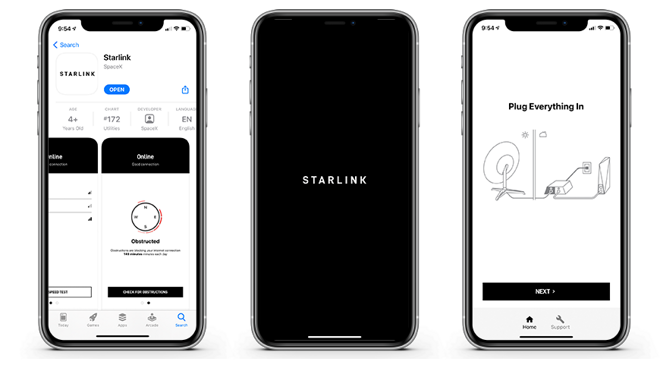Starlink starts $99 per month 'Better than Nothing' internet service beta
SpaceX is expanding its Starlink satellite internet beta to interested parties, requiring a $499 upfront purchase on top of a $99 per month fee.

SpaceX, one of the several projects from Tesla CEO Elon Musk, has sent out emails to those who expressed interest in signing up for the Starlink internet service.
The service will cost $99 per month but requires a user to purchase a $499 Starlink Kit. The kit includes a user terminal, a mounting tripod, and a WiFi Router. An iOS app for the service has recently appeared on the App Store.
The company has told customers to temper their expectations, according to an email seen by CNBC. The company itself calls it the "better than nothing beta" and warns that data speeds will likely vary between 50-150Mbps, with latency of between 20ms to 40ms -- as well as "brief" periods of no connectivity at all.
Customers had signed up to be informed about the beta via Starlink's website, and SpaceX says in less than two months, nearly 700,000 individuals had signed up to learn more about the service. The form remains open on the Starlink site.
SpaceX hopes to build an interconnected internet network with thousands of satellites that could provide high-speed internet to anyone on the planet. The company estimates that the project could cost over $10 billion to build but could bring in as much as $30 billion a year.
Currently, SpaceX has over 900 Starlink satellites in orbit, which enables the company to begin offering service to customers in some regions of the United States. According to the Starlink site, SpaceX hopes to expand to "near-global coverage of the populated world by 2021."

SpaceX, one of the several projects from Tesla CEO Elon Musk, has sent out emails to those who expressed interest in signing up for the Starlink internet service.
The service will cost $99 per month but requires a user to purchase a $499 Starlink Kit. The kit includes a user terminal, a mounting tripod, and a WiFi Router. An iOS app for the service has recently appeared on the App Store.
The company has told customers to temper their expectations, according to an email seen by CNBC. The company itself calls it the "better than nothing beta" and warns that data speeds will likely vary between 50-150Mbps, with latency of between 20ms to 40ms -- as well as "brief" periods of no connectivity at all.
Customers had signed up to be informed about the beta via Starlink's website, and SpaceX says in less than two months, nearly 700,000 individuals had signed up to learn more about the service. The form remains open on the Starlink site.
SpaceX hopes to build an interconnected internet network with thousands of satellites that could provide high-speed internet to anyone on the planet. The company estimates that the project could cost over $10 billion to build but could bring in as much as $30 billion a year.
Currently, SpaceX has over 900 Starlink satellites in orbit, which enables the company to begin offering service to customers in some regions of the United States. According to the Starlink site, SpaceX hopes to expand to "near-global coverage of the populated world by 2021."

Comments
Does anyone know if the satellite dish will require separate power or uses Power over Ethernet? When I built the house, I had the foresight to run coax and ethernet to the roof, but not power :-(
I couldn’t agree more. There is a lot of junk, and each time some yahoo conducts a ASBM test there’s more, not to mention fragments from impacts. It’s getting crowded. Also the impact on astronomy could be terrible. You already can’t go out and look at the sky without seeing a couple of satellites. Multiply that by a hundred and it will really spoil the sky.
You can always use a PoE extractor to supply remote power to a non-PoE device.
Time for Spectre to launch Bird One and start collecting all the satellites and space junk.
Starlink can't come soon enough!
But all starlink satellites has a return home feature, crash and burn back to earth, when it is end of life. It is not perfect but it is a lot better than other LEO to HEO satellites that will just die in space and stay for long time.
Not yet but Musk has talked about it. Right now this is a very limited beta release.
They are so low that without their onboard propulsion they will drop into the earth's atmosphere and burn up in just a few months. So they aren't really hurting the space junk problem as they, by design, rapidly de-orbit.
The stuff up high (Geosynchronous) is where the serious space junk issue is. That stuff will be floating around for thousands of years before they come down, even 10's of thousands of years.